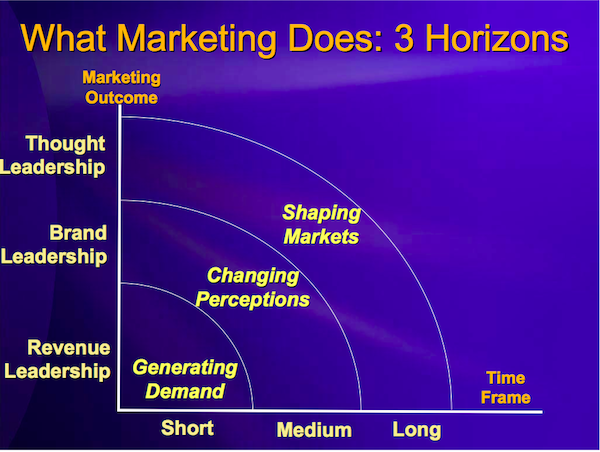Thought Leadership used to be something that came much later in the evolution of a company. It was expected after you reached some revenue, and after you established your brand leadership.Thought Leadership in the traditional sense kept companies in a market leadership position because of the insights they accumulated after their several years of experience. Consulting firms were notorious for publishing their thought leadership in order to attract clients who associated their issues with it.Here’s a slide from 2004 by my friend Mohan Sawhney, professor of Marketing at the Kellogg School of Management. But that was the old way of getting to Thought Leadership. For tech startups, the ordering sequence for thought leadership changes, although the goals of shaping markets and changing perceptions (via branding) still apply, but not in that same order. I would argue that the order today is:
For tech startups, the ordering sequence for thought leadership changes, although the goals of shaping markets and changing perceptions (via branding) still apply, but not in that same order. I would argue that the order today is:
Thought Leadership ==> Demand Generation ==> Brand Leadership
With thought leadership, you can drive demand to the idea, before you drive demand to the product. If you believe the saying that “nothing is stronger than an idea whose time has come”, then you will realize that the strength of your product will be directly related to the strength of the idea behind it. Thought leadership starts to put wind in the sails of your product.As an entrepreneur, if you have thought leadership, you can start to display it in the early stages of your market development. This is important because you are in essence educating the market or the prospective user about something that will make them want to use your product.Educating your market used to be difficult and expensive, but not anymore. Today, it ties with Inbound Marketing, where the ROI is much better than outbound marketing.You are the visionary entrepreneur who has seen the future, or a slice of it. You have a vision about your product’s role in our lives, whether it’s used for a personal or business reason. So, what are you doing to educate your market to drive demand for your idea?Publishing your thought leadership is also good for market validation. Users and readers will give you feedback, and you can orient your next moves based on that.Mark Zuckerberg’s early thought leadership was to clearly understand the psychology behind why people like to share with their friends. And everything Facebook did contributed to that enablement.I’d like to see more startups clearly articulate their vision in a thought leadership way, early on. I’ve encouraged some of the companies I’m mentoring to do that, because their market messages lacked the clarity required to become a market magnet, or they hadn’t started to write about it.You can start by publishing your thought leadership on your blog, and then you can cross-post on Medium, or submit it as an opinion piece to popular online destinations. You can also share your thought leadership on other discussion communities where your potential users hang out, because conversations are now decoupled from the content. Some of these communities include USV.com, GrowthHackers.com, Inbound.org, HackerNews, Reddit, Startup Revolution, or other B2B blog/websites.Thought Leadership is not product messaging or a list of product features. Thought leadership has to be an original juxtaposition of new ideas that are authentically yours. Done well, thought leadership cannot be copied, or it will backfire in the face of the copier. Great thought leadership will be quoted and referenced elsewhere.You can do a reality check on your Thought Leadership, by answering the following questions, and turning the answers into a blog post:
- What’s the big idea?
- How will your product uniquely transform your users or customers?
- What will they be doing that they aren’t now?
- What is your vision of that future?
- What motivated you and drove you to start your company?
- What did you see that others may not have seen yet?
- How does your product revolutionize a certain behavior that will change, as a result of it?
If you don’t think you have thought leadership behind your product, then I would ask that you rethink the product idea and push it further. There is probably going to be a correlation between the strength of your thought leadership and the market potential behind your product.
